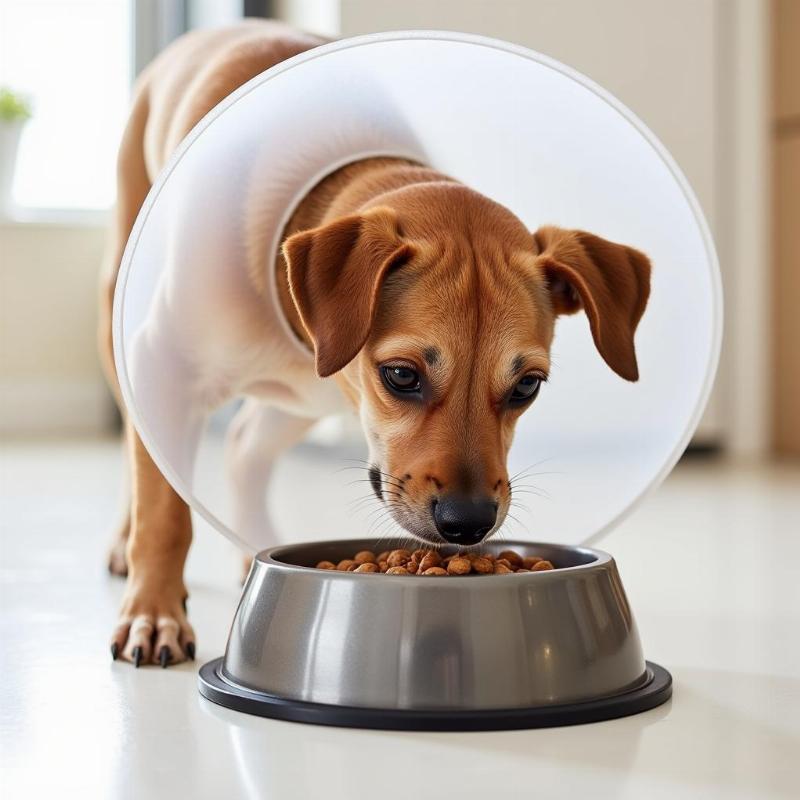Dealing with a dog who refuses to sleep with a cone can be frustrating. A cone, also known as an Elizabethan collar, is essential for preventing your dog from licking or biting wounds, stitches, or hot spots. But a restless, uncomfortable dog won’t heal properly. This article will explore why your dog might be resisting the cone and provide practical solutions to help them sleep comfortably and recover quickly.
Understanding Your Dog’s Cone Resistance
Several factors contribute to a dog’s reluctance to sleep with a cone. The cone can interfere with their normal sleeping positions, making it difficult to get comfortable. It can also restrict their vision and hearing, leading to anxiety and disorientation, especially at night. The cone itself might feel awkward and unfamiliar, causing further discomfort. Some dogs might also associate the cone with negative experiences, adding to their stress.
Tips to Help Your Dog Sleep with a Cone
Here are some practical tips to ease your dog’s discomfort and encourage sleep:
- Proper Cone Sizing: Ensure the cone fits correctly. A cone that’s too big will bump into furniture, while a cone that’s too small will allow your dog to reach their wound. Consult with your veterinarian for the right size and type of cone.
- Introduce the Cone Gradually: Don’t just suddenly put the cone on. Allow your dog to sniff and investigate it before gradually introducing it for short periods. Reward them with treats and praise for positive interactions.
- Create a Comfortable Sleeping Area: Provide a soft, supportive bed in a quiet, familiar space. Add familiar blankets or toys to create a sense of security.
- Adjust the Cone for Sleep: Some cones are adjustable. If possible, slightly loosen the cone for sleeping, ensuring it still prevents access to the wound.
- Distraction Techniques: Offer a favorite chew toy or puzzle feeder to keep your dog occupied and distracted from the cone.
- Medication: In some cases, your veterinarian might prescribe mild sedatives or anti-anxiety medication to help your dog relax and sleep.
- Alternative Cones: Consider alternatives like inflatable collars or soft recovery suits, which may be more comfortable for sleeping. Consult with your vet before switching to an alternative.
When to Contact Your Veterinarian
If your dog continues to struggle with the cone, especially if they show signs of excessive stress, pain, or self-trauma, contact your veterinarian immediately. They can assess the situation, adjust the cone, or recommend alternative solutions.
Can a Dog Wear a Cone in a Crate?
Yes, a dog can wear a cone in a crate, but ensure the crate is large enough to accommodate the cone without restricting movement or causing discomfort. You might need to upgrade to a larger crate temporarily. can a dog wear a cone in a crate
Addressing Common Concerns
Why is my dog pacing with the cone on?
Pacing can indicate anxiety or discomfort. Try adjusting the cone, creating a calming environment, and providing distractions.
Can my dog eat and drink with a cone on?
Yes, they should be able to. Adjust the food and water bowls to a height that allows comfortable access.
 Dog Eating with Cone
Dog Eating with Cone
Alternative Solutions to Traditional Cones
If your dog absolutely cannot tolerate a traditional cone, talk to your vet about alternatives, such as inflatable collars, soft e-collars, or post-surgical clothing. can i use a neck pillow as a dog cone These options can provide comfort while still protecting the wound. dog shuts down with cone
Expert Insights
Dr. Emily Carter, DVM, a renowned veterinary behaviorist, emphasizes the importance of patience and positive reinforcement when helping a dog adjust to a cone: “Creating a positive association with the cone through treats and praise can significantly reduce stress and promote acceptance.”
Dr. Sarah Miller, DVM, a specialist in small animal surgery, adds, “Proper cone fit is crucial. A cone that’s too big or too small can impede healing and increase discomfort. Always consult with your veterinarian for guidance on the appropriate cone size and type.”
Conclusion
Helping your dog sleep comfortably with a cone requires patience and understanding. By addressing their discomfort, creating a calming environment, and following these practical tips, you can ensure a smoother recovery and a well-rested pup. If you have further concerns, don’t hesitate to reach out to your veterinarian. when can i take my dogs cone off
FAQ
- How can I make my dog’s cone more comfortable? Padding the edges with soft material or using an inflatable collar can increase comfort.
- What if my dog keeps trying to remove the cone? Ensure the cone is properly fitted and consult with your veterinarian for alternative solutions or behavioral modifications.
- Is it okay to leave my dog alone with a cone on? Yes, in most cases. However, ensure they have a safe and comfortable environment.
- How long will my dog need to wear the cone? This depends on the injury and healing process. Your veterinarian will advise on the appropriate duration.
- Can I use a human neck pillow as a dog cone? No, human neck pillows are not designed for this purpose and can be dangerous.
- My dog seems depressed while wearing the cone. What should I do? Provide extra attention, comfort, and engaging activities to help alleviate their mood.
- What if my dog’s cone gets dirty? Clean it regularly with a mild disinfectant.
Beautdogs.us is your premier online resource for all things dog-related in the USA. We provide expert advice on dog breeds, care, and lifestyle, offering valuable insights for both new and experienced dog owners. From breed-specific information to expert tips on training and nutrition, Beautdogs.us is your trusted companion in navigating the joys and challenges of dog ownership. Explore our website for more information on dog health, behavior, and product reviews. Contact us at [email protected] or call us at +1 501-555-7529 for personalized guidance.